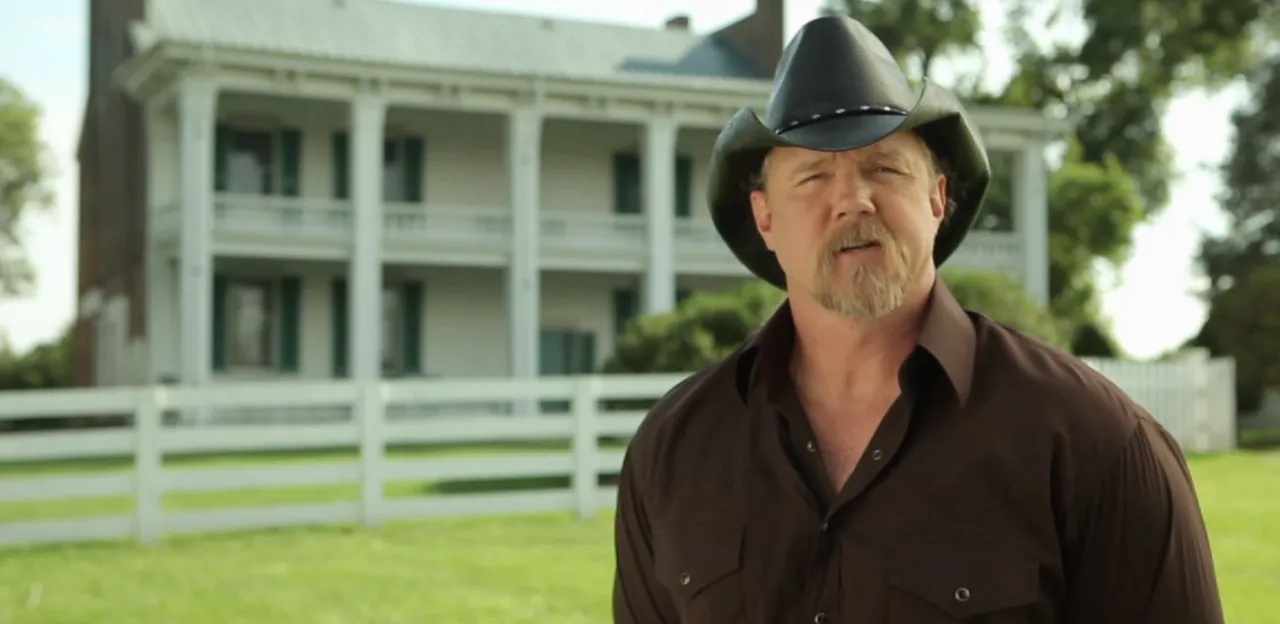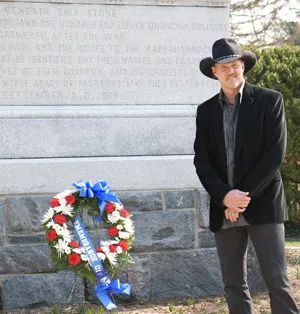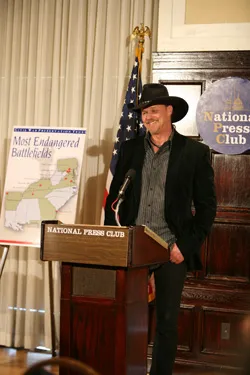Trace Adkins Lends Voice to Battlefield Preservation Cause

This article first appeared in the Spring 2008 edition of Hallowed Ground, the award-winning membership magazine from the Civil War Trust. In 2011, Trace Adkins became a new member of the Board of Trustees of the Civil War Trust.

SILHOUETTED AGAINST THE WHITE MARBLE MONUMENT IN MRS. LEE’S ROSE GARDEN, platinum-selling country music artist Trace Adkins paused, his signature black hat held over his heart. Below him was the red, white and blue wreath he had just reverently placed in front of Arlington Cemetery’s Tomb of the Civil War Unknowns. When he turned back to the small crowd assembled, emotion was visibly etched on his face. The quiet observance was particularly appropriate for a man who counts among his most popular songs the stirring and contemplative “Arlington” – the story of a fallen soldier brought to be laid to rest in the national cemetery.
On Wednesday, March 12, 2008, Adkins joined the Civil War Trust in Washington, D.C., to unveil the 2008 edition of History Under Siege, our annual report on the nation’s most endangered Civil War battlefields. Following a news conference at the National Press Club, Adkins and several guests crossed the Potomac River into Virginia to participate in the solemn ceremony before a monument containing the remains of unidentified Union and Confederate soldiers on the grounds of what was once Confederate Gen. Robert E. Lee’s home.
Despite the fame he has earned as a chart-topping singer-songwriter and finalist on the reality television series “Celebrity Apprentice,” Adkins became interested in Civil War history in the same way that generations of Americans have – through the stories of his ancestors passed down within the family.
“When I was a 13-year-old boy my grandfather sat me down one day. I guess he thought it was time for him to tell me what his grandfather had told him,” Adkins began. “His name was Henry T. Morgan and he was a private in the 31st Louisiana Infantry. He was wounded and taken prisoner at Vicksburg.”
That personal connection to history and the ardent desire to see it preserved stayed with Adkins over the years. It has spurred him to visit many of the hallowed battlegrounds of the war and reflect upon the epic sacrifices made there. Still, he said, one particular battlefield visit was particularly poignant.
“The first time I ever went to Vicksburg, I got to stand where I knew I was within 100 feet or so of where my great-great-grandfather was positioned in that battle. I knew because there’s a monument there and the trench is still there,” he told the crowd gathered at the press conference. “And you can look across that battlefield – it’s been preserved, it’s one of the success stories – and it still looks the way it looked when my great-great-grandfather was there. I can’t explain to you what a spiritual moment that was for me.”
Growing up in Sarepta, La., and now living near Nashville, Tenn., Adkins has spent much of his life surrounded by Civil War battlefields. The seriousness of the threat to these unique resources, however, was truly brought home to him one winter day while stuck in traffic on Interstate 65 in middle Tennessee. Glancing out the window of his truck between sips of coffee, Adkins realized that he was stopped within site of Overton Hill, its slopes now occupied by a high school, football stadium and a smattering of small businesses. Suddenly, a thought struck him: it was December 15.

“I thought, if I got out of my truck right now and I went randomly walking up and down this interstate, knocking on a few people’s windows, asking them if they knew what happened on that hill 143 years ago on this very day, could they tell me? ‘Do you know that somebody wrote that you could walk from the bottom of that hill to the top without putting your foot on the ground – that you could walk on soldiers’ bodies up that hill? That blood was literally flowing down that hill on this morning 143 years ago?’”
Sadly, he was forced to admit to himself, there probably wasn’t a car within half a mile with an occupant who could recite the story. That moment was when Adkins realized the importance of preserving Civil War sites now, before they are paved over and forgotten.
“This is something that means a lot to me, and it’s going to mean a lot to my children,” he said. “And it’s going to mean a lot to my grandchildren if I’m still around. Because it was imparted to me by my grandfather and I’m going to continue to do the same. And I’m going to do what I can do to help the Civil War Trust.”
According to Civil War Trust president Jim Lighthizer, Adkins words are both sad and all too accurate. The difference, he said, between a battle that is written about and taught to our children and one is largely forgotten can be summed up in one word: preservation. As an example, he offered the contrast between Pickett’s Charge at Gettysburg, Pa., and a similar frontal assault at Franklin, Tenn., near where Adkins makes his home.
“They were both very significant – except that Franklin had about twice as many casualties. It probably lasted two or three times as long, the attackers went twice as far against much greater odds. And, yet, we don’t remember it. What is the one variable that’s different? Around the turn of the twentieth century, we paved over Franklin.”
A huge number of battlefields are threatened by sprawl from growing towns and cities, but, Lighthizer pointed out, several of the sites in this year’s list demonstrate an even more disheartening trend – potentially debilitating threats to sites that had long been counted as “victories” by preservationists. We must be vigilant, he said, lest our previous successes be overshadowed by ill-considered new proposals.
For example, Antietam, which Lighthizer characterized as a model of thorough and meaningful preservation, thanks to investments totaling in the tens of millions of dollars from the federal government and state and local governments, as well as private groups. Today, Antietam, is faced with a proposal for a cell phone tower that would rise 120 feet and be visible from many of battlefields most historic sites.
“You can come to Antietam and see it almost exactly as it was 140-some years ago. The viewshed is almost exactly what it was 140-some years ago. So you have a context, you can get a feel. You can see what they saw and you can almost touch what they touched, as far as the land goes,” Lighthizer said. “When you stick up a monstrosity of a cell tower … you really desecrate the visual environment.”
Note: Following this outspoken opposition from the Civil War Trust and others, the developers proposing the cell tower discussed above soon withdrew their plans. The skyline and viewshed at Antietam National Battlefield remains largely unspoiled.
That visual environment is a critical part of the learning experience that students of all ages can gain from visiting Civil War battlefields, said Cricket Bauer Pohanka, the event’s final speaker. A Civil War Trust trustee and historian in her own right, as well as the wife of the late Brian Pohanka, one of Civil War Trust’s founders, she spoke of the universal educational opportunities offered by these sites. “Preserved battlefields are not just beautiful landscapes,” Pohanka said. “They are outdoor classrooms that teach us what it means to be an American.”





